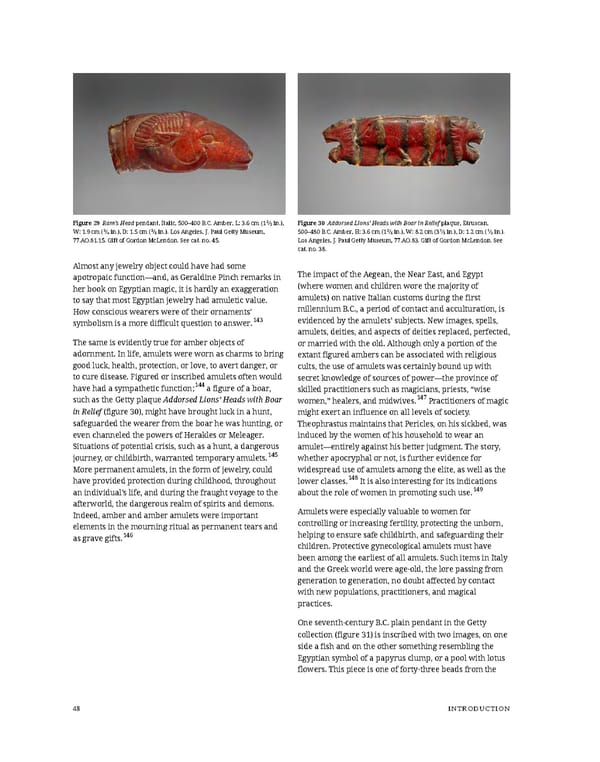Figure 29 Ram’s Headpendant, Italic, 500–400 B.C. Amber, L: 3.6 cm (12⁄5 in.), Figure 30 Addorsed Lions’ Heads with Boar in Relief plaque, Etruscan, W: 1.9 cm (3⁄4 in.), D: 1.5 cm (3⁄5 in.). Los Angeles, J. Paul Getty Museum, 500–480 B.C. Amber, H: 3.6 cm (12⁄5 in.), W: 8.2 cm (31⁄5 in.), D: 1.2 cm (1⁄2 in.). 77.AO.81.15. Gift of Gordon McLendon. See cat. no. 45. Los Angeles, J. Paul Getty Museum, 77.AO.83. Gift of Gordon McLendon. See cat. no. 38. Almost any jewelry object could have had some apotropaic function—and, as Geraldine Pinch remarks in The impact of the Aegean, the Near East, and Egypt her book on Egyptian magic, it is hardly an exaggeration (where women and children wore the majority of to say that most Egyptian jewelry had amuletic value. amulets) on native Italian customs during the first How conscious wearers were of their ornaments’ millennium B.C., a period of contact and acculturation, is symbolism is a more difficult question to answer.143 evidenced by the amulets’ subjects. New images, spells, amulets, deities, and aspects of deities replaced, perfected, The same is evidently true for amber objects of or married with the old. Although only a portion of the adornment. In life, amulets were worn as charms to bring extant figured ambers can be associated with religious good luck, health, protection, or love, to avert danger, or cults, the use of amulets was certainly bound up with to cure disease. Figured or inscribed amulets often would secret knowledge of sources of power—the province of have had a sympathetic function;144 a figure of a boar, skilled practitioners such as magicians, priests, “wise such as the Getty plaque Addorsed Lions’ Heads with Boar women,” healers, and midwives.147 Practitioners of magic in Relief (figure 30), might have brought luck in a hunt, might exert an influence on all levels of society. safeguarded the wearer from the boar he was hunting, or Theophrastus maintains that Pericles, on his sickbed, was even channeled the powers of Herakles or Meleager. induced by the women of his household to wear an Situations of potential crisis, such as a hunt, a dangerous amulet—entirely against his better judgment. The story, journey, or childbirth, warranted temporary amulets.145 whether apocryphal or not, is further evidence for More permanent amulets, in the form of jewelry, could widespread use of amulets among the elite, as well as the have provided protection during childhood, throughout lower classes.148 It is also interesting for its indications an individual’s life, and during the fraught voyage to the about the role of women in promoting such use.149 afterworld, the dangerous realm of spirits and demons. Indeed, amber and amber amulets were important Amulets were especially valuable to women for elements in the mourning ritual as permanent tears and controlling or increasing fertility, protecting the unborn, as grave gifts.146 helping to ensure safe childbirth, and safeguarding their children. Protective gynecological amulets must have been among the earliest of all amulets. Such items in Italy and the Greek world were age-old, the lore passing from generation to generation, no doubt affected by contact with new populations, practitioners, and magical practices. One seventh-century B.C. plain pendant in the Getty collection (figure 31) is inscribed with two images, on one side a fish and on the other something resembling the Egyptian symbol of a papyrus clump, or a pool with lotus flowers. This piece is one of forty-three beads from the 48 INTRODUCTION
 Ancient Carved Ambers in the J. Paul Getty Museum Page 57 Page 59
Ancient Carved Ambers in the J. Paul Getty Museum Page 57 Page 59